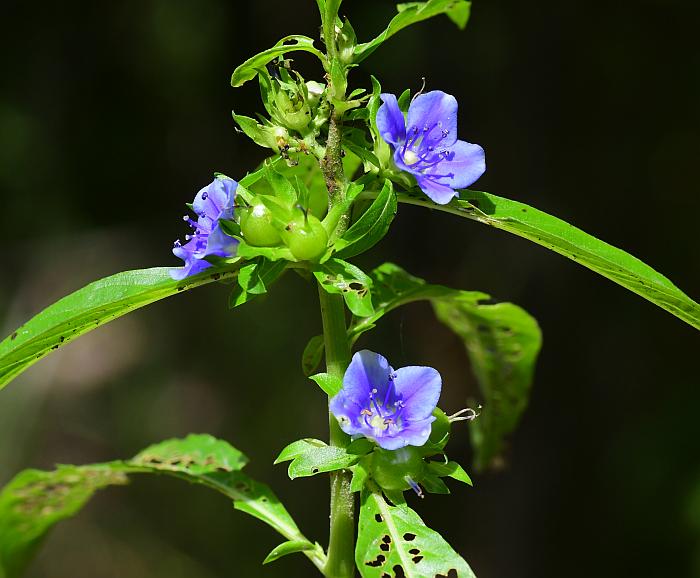Hydrolea uniflora Raf.
Hydrolea

Native
CC = 6
CW = -5
MOC = 11
© SRTurner
Hydrolea uniflora Raf.Hydrolea | |
 |
Native CC = 6 CW = -5 MOC = 11 |
© SRTurner |
|
Family - Hydroleaceae Habit - Perennial forb with fibrous roots and sometimes rhizomes. Stem - Prostrate with erect or ascending branches, to 60 cm, branched, glabrous or finely pubescent, often rooting at lower nodes. Thorns often present, singly or paired, in leaf axils.
Leaf - Alternate, simple, sessile or short-petiolate, to 10 cm long, lanceolate or narrowly elliptic, tapered to a sharply pointed tip, angled or tapered at the base, the margins entire or minutely toothed, sometimes also slightly wavy and often minutely hairy, the surfaces glabrous or sparsely to moderately pubescent with fine, minute, straight, spreading hairs.
Inflorescence - Axillary clusters.
Flowers - Actinomorphic, hypogynous, perfect. Calyces deeply 5-lobed, lobes 5-8 mm, ovate, glabrous or finely pubescent, occasionally with sparse, sessile glands. Corollas deeply 5-lobed, 7-11 mm long, lobes broadly elliptic and rounded at tips, blue. Stamens 5, filaments broadened at base and adnate to base of corolla. Pistil 1, of 2 fused carpels.
Fruits - Globose capsules, longitudinally dehiscent, glabrous. Seeds numerous.
Flowering - June - September. Habitat - Bottomland forests, pond margins, swamps, sloughs, ditches, wet roadsides. Origin - Native to the U.S. Lookalikes - H. ovata. Other info. - This attractive but uncommon species is restricted to the Mississippi Lowlands division, which is the northern extent of its natural range. Beyond Missouri it occurs in only a few other states. The plant is always a welcome find, though it must be handled with care (if at all) due to the viciously sharp thorns which are usually present. The flowers are larger than those of the close relative, H. ovata. Photographs taken at Otter Slough Conservation Area, Stoddard County, MO, 8-13-2015 and 8-7-2022, and at Big Cane Conservation Area, Butler County, MO, 9-7-2019 (SRTurner). |